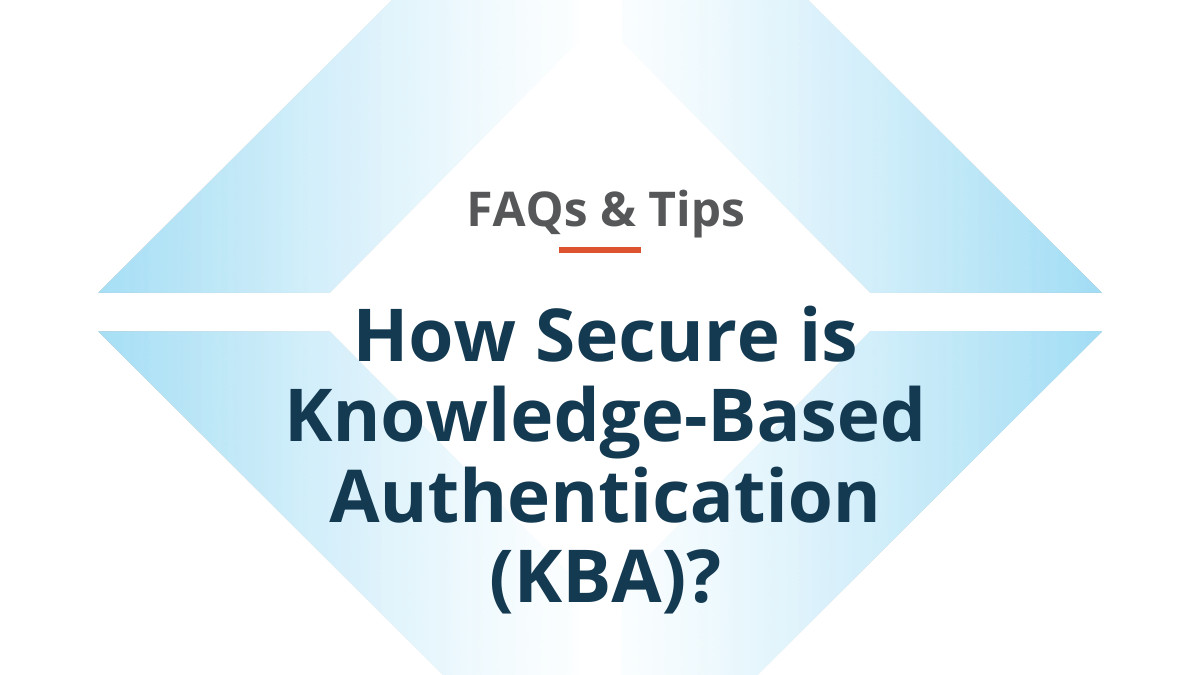
July 10, 2023 | Veratad Blog | Category: Identity Verification
How Secure is Knowledge-Based Authentication (KBA)?
Many concerns have been raised over the security of Knowledge-Based Authentication (KBA). However, it’s not accurate to say that KBA is truly dead. When deployed correctly, KBA can be a vital layer of security in any onboarding, transaction, or account login process.
What is KBA?
Knowledge-Based Authentication (KBA) is an identity verification method that uses personalized questions based on an individual’s personal information. It aims to ensure that the person requesting access is the legitimate account owner by challenging them with specific questions.
The Importance of Security in Identity Verification
Security in your identity verification process is vital to prevent unauthorized access, protect personal information, and mitigate fraud and financial losses. By establishing and verifying individuals’ identities, organizations can ensure that only authorized individuals have access to their systems and confidential data, reducing the risk of data breaches and identity theft.
Compliance is also important to consider here. Financial institutions and fintech companies must comply with regulations and legal requirements, such as KYC and AML. One of the main requirements of those regulations is a secure process for verifying a customer’s identity.
Moreover, a secure identity verification process builds trust and confidence among users, fostering loyalty and maintaining a positive reputation for businesses. Thus, organizations that prioritize a more secure verification environment for their customers to complete online transactions, share information, and interact with digital services will reap the benefits of a more satisfied customer base.
Common Challenges to KBA Security
While KBA is still a viable method of identity verification, there are several reasons why people raise concerns over its security. Many of those reasons center around the accessibility of personal information online.
Data breaches, social media platforms, and the availability of public records have all contributed to an increase of readily available personal information. This makes it easier for attackers to gather the necessary information to impersonate legitimate users and bypass KBA questions.
Of course, KBA can be exploited, but so can other identity verification methods. The important thing to keep in mind is how best to deploy KBA so your process is as secure as possible. Let’s cover some of the ways KBA is a secure identity verification method and how it can be deployed.
3 Reasons KBA is a Secure & Effective Method for Identity Verification
Reason #1: Access to Private Information
Dynamic KBA is a type of KBA that generates context-specific questions that draw from private records. The questions may range from demographic questions to questions related to credit transactions and the timing of life events. These types of questions are much harder for fraudsters to crack.
Reason #2: KBA Can be Deployed as an Added Layer of Security
KBA is most beneficial when used in combination with other verification methods or as part of a layered identity verification strategy. We will touch on some of those combinations later in this article.
Reason #3: It’s Widely Used
KBA has been implemented across many industries and organizations, proving its effectiveness and acceptance as a secure identity verification method. Moreover, users are accustomed to the KBA process, and many still view it as an essential security measure.
How to Make KBA More Secure
The main way to make KBA a more secure form of identity verification is to use it in conjunction with other common methods. In fact, when used as part of a multi-layered identity verification strategy, KBA can add tremendous value, enhancing assurance and security. Let’s explore a few examples.
Two-Factor Authentication (2FA) + KBA
KBA can be used as one factor in a 2FA setup. After the user provides a piece of information they know (e.g., a password), they can be prompted with KBA questions to further validate their identity. This combination adds an extra layer of assurance.
Document Verification + KBA
This combination uses KBA to add an additional layer of security after identification documents have been verified. This reduces reliance on documents alone, balances security with user experience, and helps prevent fraud attempts based on stolen or counterfeit documents.
Data Verification + KBA
Data verification involves validating an individual’s identity by cross-referencing their provided information against a variety of reliable data sources. KBA can be used in conjunction with data-based verification methods as an added step, requiring knowledge of secure personal information to proceed.
Biometric Authentication + KBA
Biometric authentication, such as fingerprint or facial recognition, can often fail, turning away valid users. KBA can be an effective fallback method or an additional layer of security to verify that the person is who they say they are. Users first provide their biometric data, which is compared to a stored template. If the biometric match is successful, they can be asked KBA questions as an additional layer of assurance.
Conclusion: KBA is a Secure and Viable Verification Method
While KBA has faced many critiques in the past, it’s still a viable method for identity verification when deployed correctly. Of course, you don’t want to allow fraudsters and malicious actors through. By the same token, you also don’t want to ruin the customer experience. Working with an identity verification expert to configure and optimize the perfect KBA workflow can help you ensure your identity verification process is secure without sacrificing the customer experience.



